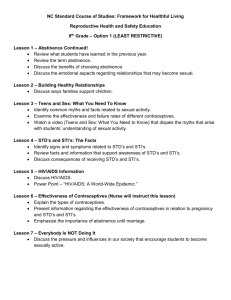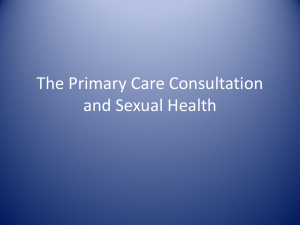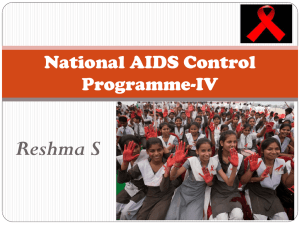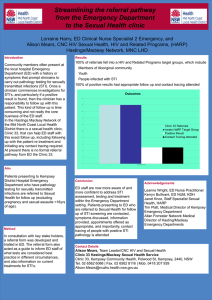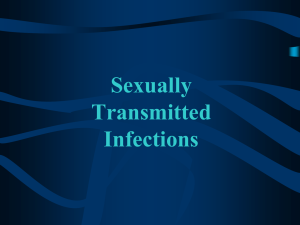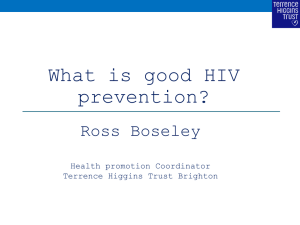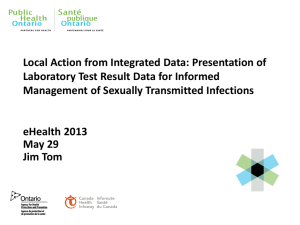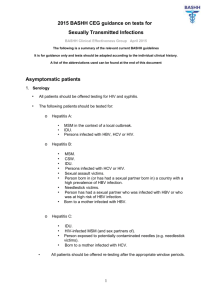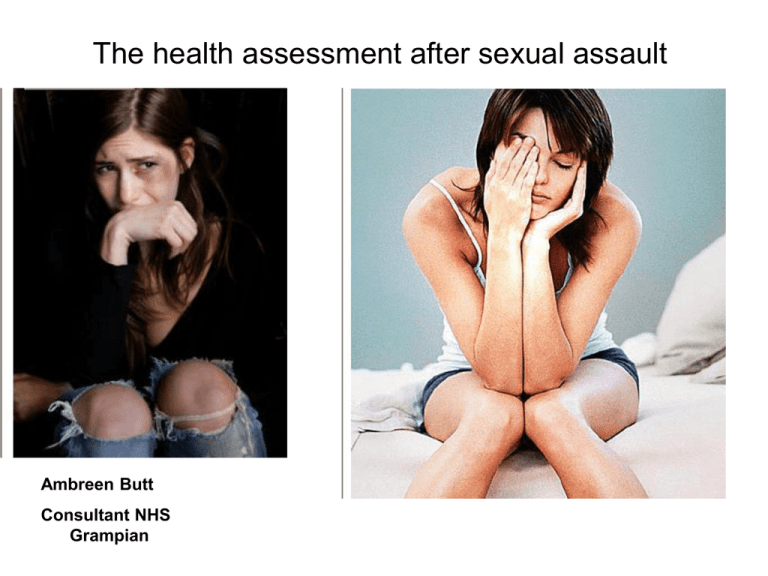
The health assessment after sexual assault
Ambreen Butt
Consultant NHS
Grampian
Immediate Needs (within 7 days)
• Immediate safety
• Treatment of injuries
Should take precedence over clinical
management
Vaginal tears
Palatal Petechaie
Clinical Management
• Emergency Contraception
• STI screening follow up
• BBV testing/Serum save
• STI Prophylaxis
• Hep B prophylaxis
• HIV PEPSE
The need for any/all of these should start with a
detailed sensitively taken sexual history
EMERGENCY CONTRACEPTION
Offered to all women and adolescents
who have had
• Unprotected vaginal sexual intercourse
• Potential failure of contraceptive method
e.g. recent missed pills
EMERGENCY CONTRACEPTION
• Levonelle 2
• ellaOne
• Copper IUCD
Fast track client
Infections
STI identification is unlikely to assume
evidential importance except in certain
circumstances
• Young people – children and adolescents not
previously sexually active
• Elderly – if no recent consensual sexual activity
• Sexually inexperienced orifice
Chain of evidence
Finding an STI may influence the level of criminal injuries
compensation
Screening for STIS
• What, if any examination required?
• What tests to take and from what sites?
Infections
Most commonly identified STIs after
sexual assault
• Chlamydia- Dual NAAT
• Gonorrhoea – Dual NAAT+/- culture
• Trichomoniasis - direct microscopy
Offer all clients an examination
• if declines then self swab is sufficient to
test for chlamydia and gonorrhoea where
dual NAAT testing is available – should be
done at time of presentation and repeated
if necessary after 2 weeks
• Remember to sample all sites affected
In a Primary Care setting where dual NAAT
testing available
• If examined –Dual NAAT from all sites
affected and in female complaining of
vaginal discharge do HVS.
• if declines examination then can self swab
from all sites affected
Consider referral to specialist services if
symptomatic
STI ANTIBIOTIC PROPHYLAXIS
Consider
• In situations where patient may default
• Unable to tolerate the distress of repeat
examination
• Requires IUCD for EC
STI ANTIBIOTIC PROPHYLAXIS
Advantages
• Reduce the need for tests
• Lesson chance of missed infection
• Decrease the chances of detecting a
bacterial STI
STI ANTIBIOTIC PROPHYLAXIS
Disadvantages
• Unnecessary treatment
• Reinforcing belief that high risk of infection
• Missing out on partner notification
STI ANTIBIOTIC PROPHYLAXIS
First line antibiotics
• Cefixime 400mgs
• Azithromycin 1g
• Metronidazole 2g
BBV Screen/Serum save
• Offered to all at presentation
HEP B VACCINATION
Should be offered to victims of sexual
assault – risk assessment- if risk unknown then should be given
May be of value up to 6 weeks after event
Super-accelerated course recommended as more rapid protection and
adherence better
Vaccination interval 0, 1, 3 weeks and 1 year
High risk of hep B- Immunoglobulin ASAP and no later than 7 days
PEPSE
POST EXPOSURE PROPHYLAXIS
FOR HIV FOLLOWING
UNPROTECTED SEXUAL EXPOSURE
PEPSE
RISK OF HIV TRANSMISSION =
RISK THAT THE SOURCE IS HIV
POSITIVE x RISK OF EXPOSURE*
(*including cofactors such as co-existing
sexually transmitted infections, high viral
load and bleeding/trauma)
PEPSE
Table 1 Risk that source is HIV positive
Community group
Homosexual men*
London
Scotland
Elsewhere
Heterosexuals
(region of birth)
UK
Rest of Europe
North America
Central and South America
Caribbean
North Africa and Middle East
Sub-Saharan Africa
South Asia
East and South East Asia
Australasia
Injecting drug users*
London
Elsewhere in the UK
HIV seroprevalence (%)
20.30
3.20
3.60
Male (%)
Female (%)
0.5
2
2.9
2.4
1.2
0.5
6.9
0.5
0.5
0.8
0.2
0.2
0.1
0.9
1.0
0.4
11.3
0.6
0.7
0.1
2.90
0.50
HPA data, 2004. Contemporaneous prevalence estimates can be obtained at:
[www.hpa.org.uk/infections/topics_az/hiv and sti]
HPA data 2004, HIV prevalence among GUM attendees by world region of birth in 2003. Prevalence rates for exposures outside of the UK or
for individuals recently moved to the UK can be obtained at: [www.unaids.org]
BASHH RECOMMENDATION FOR
PRESCRIBING PEP
BASHH RECOMMENDATION FOR
PRESCRIBING PEP
Factors influencing the effectiveness of PEP as identified in
the BASHH guidelines are:
• Delay in starting treatment, with PEP seen as possibly
less effective or ineffective after 72 hours but possibly
still considered if exposure is ‘high risk’
• Drug-resistant strains of HIV may reduce PEP’s
effectiveness with resistance testing of the ‘source’ of
infection considered and/or factoring in resistance when
prescribing PEP drug combinations
• HIV remaining in parts of the body where antiretroviral
drugs’ ability to penetrate is variable
• Poor adherence to the PEP drug regime
PEPSE
SIDE EFFECTS
Mild
• Nausea and diarrhoea- supportive treatment
with Domperidone and Loperamide
Serious
• Lipid abnormalities
• Liver problems
• Diabetes and insulin resistance
PEPSE
PRESCRIBING RECOMMENDATIONS
• Nucleoside reverse transcriptase inhibitors
(NRTIs)
• Non-nucleoside reverse transcriptase
inhibitors (NNRTIs)
• Protease inhibitors (PIs)
PEPSE
Current pack consists of the following drugs:
TRUVADA
• Tenofovir 245 mg once daily
• Emtricitabine 200mg once daily
KALETRA
• Ritonavir boosted Lopinavir 2 tablets twice daily
Initial pack contains 5 days supply
Treatment given for 4 weeks
28 day course cost around £650
Follow up
• Repeat STI screen 2 weeks after sexual
assault
• Pregnancy testing
• HIV testing- can be done at 1 and 3
months (4 months if taken PEPSE)
• Syphilis testing- 3 months
• Hep B and C testing - at 3 and 6 months
• Review psychosocial needs and coping
BASHH Guidelines
Management of adult and adolescent
complainants of sexual assault (2011)
http://www.bashh.org/documents/
3275

